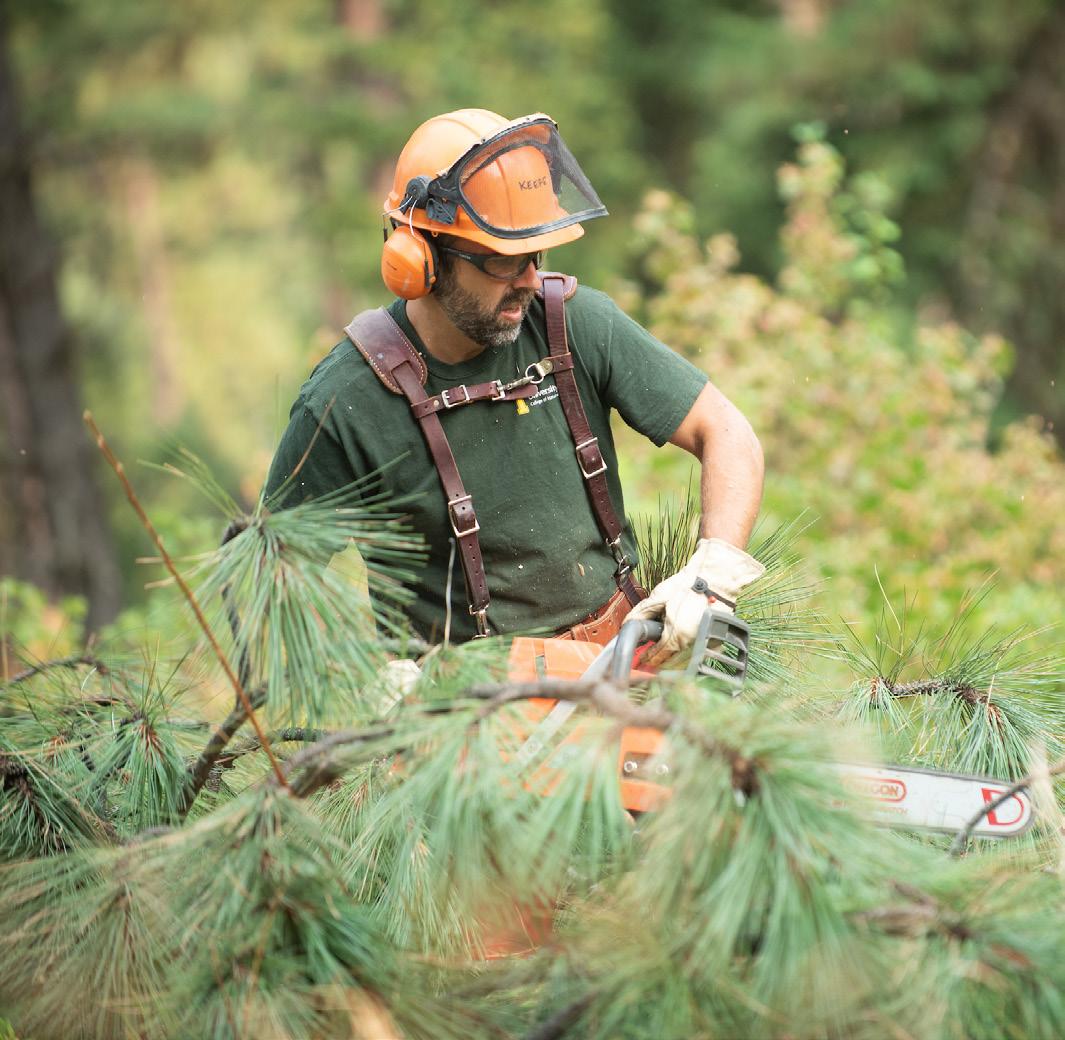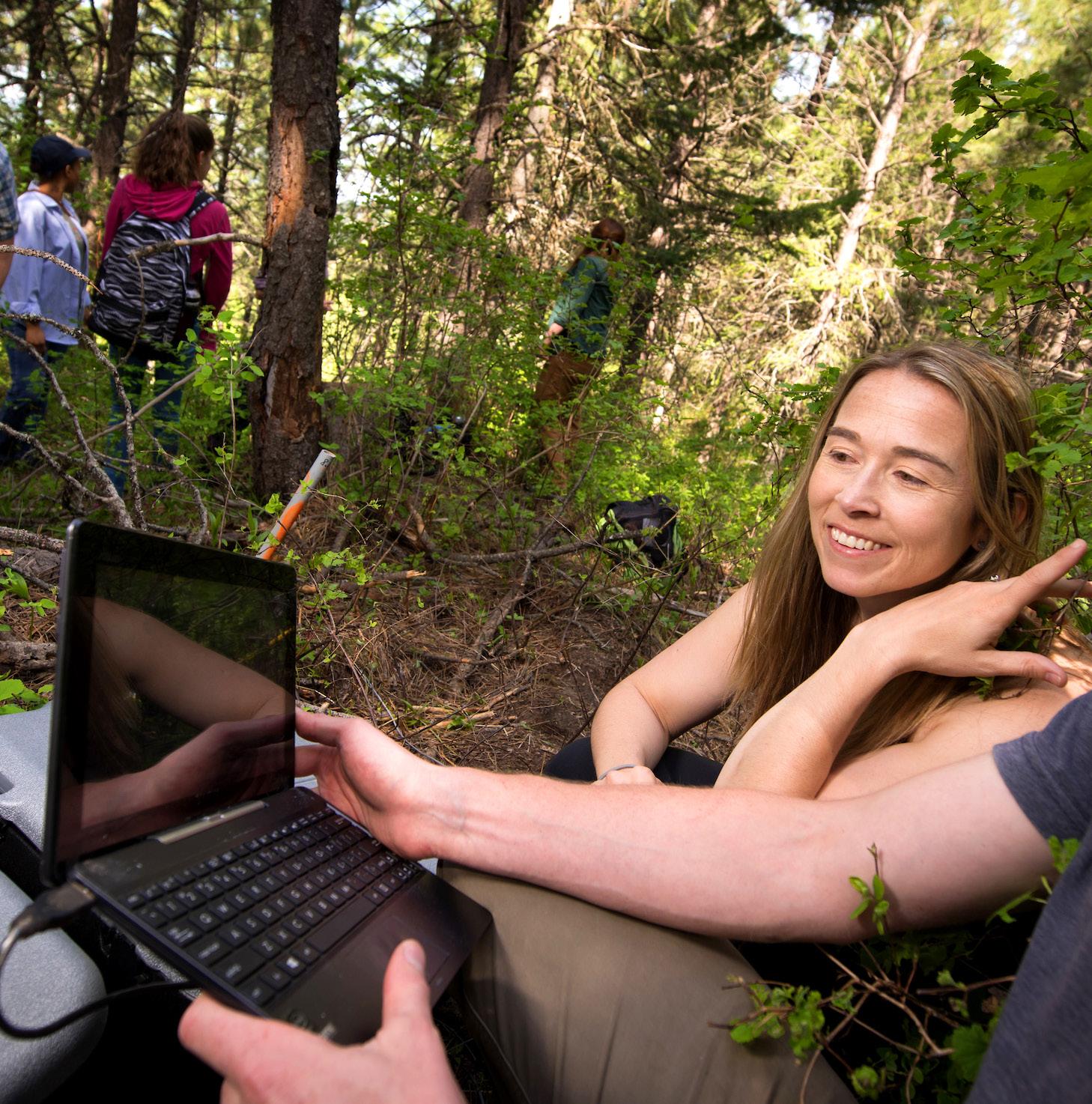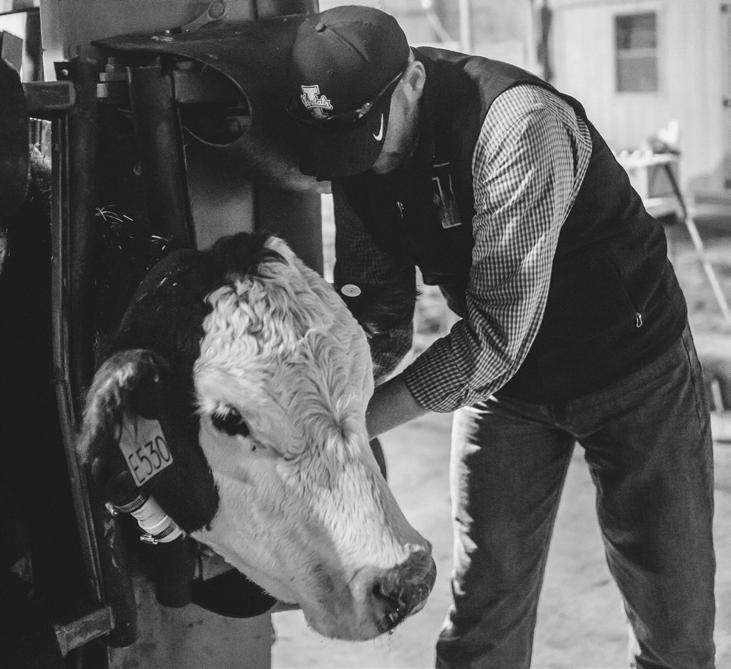
7 minute read
Forest, Rangeland and Fire Sciences
Wildland Firefighter Health Studies Gain National Attention
PHOTO: BO BROOKS
RESEARCH LOOKS AT ROLE OF FATIGUE, DIET IN FIRE SITE ACCIDENTS
As fire seasons grow longer, wildland firefighters are getting really tired. Randy Brooks knows exactly how tired. This summer, the forestry professor tracked 18 smokejumpers with the help of advanced motion monitors that use an algorithmic fatigue model originally developed for the U.S. military. The Associated Press got wind of Brooks’ work in August and the resulting article was published in more than 65 media outlets across the country. “Ultimately, I hope this research, and the attention it has received, will help save lives,” Brooks said. Both of Brooks’ sons are wildland firefighters. After a tragic fire killed three fellow firefighters in 2015, Bo Brooks asked his father if he could help through research. So Randy Brooks and doctoral student Callie Collins started with a survey of more than 400 wildland firefighters that pointed to fatigue as one of the main contributors to accidents. A pilot study followed in summer 2017 with nine smokejumpers who were outfitted with motion monitors that keep detailed data on sleep and activity. The firefighters spent more than 42 percent of a month working in impaired conditions with reaction times slowed by 34 to 100 percent. They also lost muscle mass over the season, despite their physically demanding work and high caloric input. Brooks’ team followed 18 smokejumpers in summer 2018 and plans to expand the project in 2019 to follow as many as 100 firefighters as well as explore possible interventions.

Using Technology to Improve Safety on Logging Sites
PROJECT AIMS TO HELP PREVENT AND DETECT ACCIDENTS
Logging is the most dangerous profession in the United States. Associate Professor Rob Keefe is leading research to use technology to make harvesting timber safer. Loggers work in remote areas, and one practical way to improve safety is simply increasing awareness among coworkers where their colleagues are at any given time, especially in relation to falling trees, moving equipment and logs, and other jobsite hazards. With the help of an $825,000 grant from the CDC’s National Institute for Occupational Safety and Health, Keefe’s team has been developing ways to use GPS-based devices to increase that location awareness among logging crews. “The great thing is there are now multiple technologies we can use to map people and equipment in the woods where there’s no cell service,” said Keefe. “We can go through satellites and use miniature radios that pair with your phone to allow safety apps to work offline.” Keefe and doctoral student Eloise Zimbelman recently received a grant from the Pacific Northwest Agricultural Safety and Health Center to use GPS activity watches, like those made by Garmin and Fitbit, to monitor work activities and send alerts to coworkers nearby if a possible accident has occurred on logging site.

Tackling the Northwest’s Wildfire Problem from Many Angles
PHOTO: STACY ISENBARGER
CRYSTAL KOLDEN LEADING $2.8 MILLION MULTIDISCIPLINARY PROJECT
Wildfire in the Northwest is not going away. According to Associate Professor Crystal Kolden, the best thing people can do is learn how to live with fire by mitigating its impacts. As a fire scientist, Kolden is doing just that. She is leading a multidisciplinary project funded by a $2.8 million National Science Foundation grant to help communities become more resilient to wildfires. “It’s about finding solutions people can embrace, so they are prepared because the one thing we can just about guarantee is that larger and more extreme wildfires are inevitable,” she said. Kolden is a pyrogeographer who studies how wildfire impacts large landscapes. The project team also includes hydrologists, economists and social scientists as well as art and architecture faculty. The project, called FireEarth, will ultimately identify Northwest communities that are most vulnerable to fire’s negative impacts and model potential management solutions to help communities better adapt. The key, Kolden said, is addressing the problem from both physical and social angles by projecting where fires will have severe consequences and matching potential solutions with what is feasible for those communities. For example, it is not realistic to expect every homeowner in a lower-income rural community to spend thousands of dollars remodeling homes to be fire-resistant. But that same community may be able to build and maintain a firebreak on private lands.

Investigating the Sustainability of Biofuels
RESEARCHER RECEIVES $750,000 DEPARTMENT OF ENERGY GRANT
Assistant Professor Tara Hudiburg’s team is hard at work after receiving a $750,000 grant from the Department of Energy to study biofuels. The project is part of a larger $104 million initiative involving 60 researchers across 17 institutions to create a new generation of sustainable, cost-effective bioproducts and bioenergy. Hudiburg’s team, which includes doctoral student Danielle Berardi and post-doctoral fellow Jeff Kent, is leading the biogeochemical modeling portion of the initiative. They are working on assessing greenhouse gases, improving predictions of future crop yields and determining the impacts of different cropping systems on soil health, biodiversity and water quality. “This project will advance the energy security of the U.S. while examining the economic sustainability and environmental impact of a bio-based economy,” Hudiburg said. “We are taking a holistic approach to help improve U.S. energy supply and reduce environmental impacts.”
Keep up with Forest, Rangeland and Fire Sciences!
Visit uidaho.edu/cnr/getnews to sign up.

USDA-Funded Projects Aim to IMPROVE

Rangeland Management
NEW FACULTY MEMBER SECURES USDA GRANTS, TOTALING $1.28 MILLION
Jason Karl is very busy these days. He is the lead investigator on two projects recently funded by the U.S. Department of Agriculture (USDA) Natural Resources Conservation Services’ Conservation Innovation Grant program. Both projects involve using technology to improve rangeland management. Each is funded by a USDA grant worth more than $600,000 with matching funds from U of I and other partners.
USING SATELLITE IMAGERY TO STUDY GRAZING PATTERNS
Ranchers and land managers would like to know more about how their cattle use the land—specifically, when, where and how much forage they consume. Karl is leading a new project that combines satellite imagery and GPS technology with on-the-ground observations to give ranchers a new grazing management tool. In the three-year project called Deploying CERT (Climate Engine Rangeland Tool), researchers will equip 300 to 400 cows with special GPS collars developed by Karl at the Zumwalt Prairie Preserve in Oregon, and on private ranches and Bureau of Land Management lands in southern Idaho. The resulting maps and forage utilization data will be built into the CERT, an online tool to analyze and visualize information on how much forage livestock consume. The data will also be linked to field observations of forage utilization with remote sensing techniques for mapping forage availability and change developed by Vincent Jason, who recently earned his Ph.D. from the College of Natural Resources. “Ultimately our goal is to create online maps that ranchers and land managers can use to see how forage availability and livestock consumption are changing over a growing season,” Karl said. “That will help them make more informed decisions on when to move cattle and how to better to manage their lands.”
NATIONAL GRAZINGLAND INFORMATION SYSTEM
While a wealth of information exists on grazing and management practices for rangelands, it can be challenging to find. The information is spread across the internet, and current search technologies are not tuned to rangeland management terms. Karl is leading the National Grazingland Information System project to help put information at the fingertips of ranchers and extension specialists. Drawing on the deep expertise of the Rangelands Partnership, a collaborative of rangeland professionals and librarians in 19 states, and the GlobalRangelands.org information portal, Karl’s team will organize and catalog information to build a modern system for discovering and accessing relevant reference materials. One of the project’s goals is to create a web-based, mobile-friendly app with online and offline capabilities, so land managers can use the app whether they are in the office or out in the field. Near the end of the project, Karl’s team will host workshops and training sessions delivering the new information portal and mobile app back to these stakeholders.
The Power of an Endowed Chair

Endowed chairs and professorships help recruit star faculty and provide funding to support their research, including opportunities for student research. They also help establish a legacy of leadership at the College of Natural Resources. Jason Karl is a prime example. He joined the CNR faculty in 2017 as the Harold F. and Ruth M. Heady Endowed Chair in Rangeland Ecology. Harold Heady, ’38, was a noted rangeland ecologist who helped found the Society of Range Management. The generous fund he and his wife Ruth left behind is meant to carry this legacy at University of Idaho. The chair helped bring Karl to CNR, and his leadership is already apparent. In addition to the USDA grants awarded in his first year on the faculty, Karl is also the head of the University of Idaho Drone Lab, which brings together faculty and students from multiple colleges at the university to collaborate and share information about using this new technology.
PHOTO ABOVE AND INSET AT LEFT: ANNETTE LEWIS

